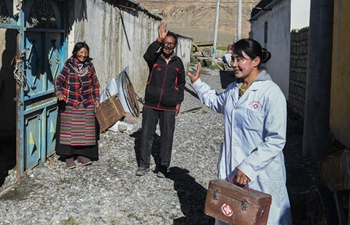KUNMING, Aug. 3 (Xinhua) -- How to stop her one-year-old son from crying had been a headache for Li Yunli, owner of an online store in central China's Hunan Province, until one day she happened upon a "cry stopper" -- the shining screen of her mobile phone.
The phone had henceforth become her son's toy and Li was relieved that she could focus more on her business. But one year later, she found that her son had become nearsighted.
"The proportion of non-genetic myopia is on the rise among little children," said Qu Jia, head of the ophthalmology center in Wenzhou Medical University.
Overloaded schoolwork, insufficient physical exercise as well as overuse of eletronic devices have resulted in a surge in myopia among children and teenagers in China.
As of 2018, over half of China's children and teenagers suffer from nearsightedness, with the rate of myopia among them reaching 53.6 percent, according to research unveiled by the National Health Commission earlier this year.
"Our generation spent almost all our childhood in the open air while kids now hardly go outdoors, and when they learn and play, they use mobile phones and computers," said Yang Zhikuan, 55, professor at Aier School of Ophthalmology, Central South University.
"Our lifestyle has changed a lot, giving rise to more risks of nearsightedness, but most parents still care too little about the eyes of their kids," Yang said.
A report on the physique of Chinese students published last year estimated that over 100 million primary, junior and senior high school students suffer from myopia. The prevalence of intense myopia has also become alarming with the percentage of senior students in high schools who wear glasses stronger than six diopters rising to 21.9 percent.
China rolled out a scheme last year to curb the rise in nearsightedness among children and teenagers. The scheme, jointly issued by the Ministry of Education, the National Health Commission and six other departments, aims to keep the myopia rate among six-year-olds at around 3 percent by 2030, and the rate among junior and senior high school students below 60 percent and 70 percent, respectively.
The Ministry of Education has also put forward a proposal recently and advised schools and parents to reduce workloads, increase outdoor activities and set a daily one-hour limit for the use of electronic devices.
"It is scientific that increasing outdoor activities can effectively prevent shortsightedness," said Zhao Mingwei with Peking University Health Science Center. "Nearsightedness is caused by changes to the axis oculi, and outdoor activities can promote the secretion of active substances that can resist the change and inhibit the development of nearsightedness.
Many countries have set standards outlining minimum daily outdoor exercise for children. Schools in Canada regulate that children should stay outdoors for no less than two hours every day and the time for low-grade children is 4.5 hours. In Australia, the amount of daily outdoor exercise is three to four hours. Experts advise Chinese children and teenagers should continue to exercise outdoors after school.
Nearsightedness is not curable and current medical techniques such as acupuncture and massage can only alleviate eye fatigue. What's more, intense myopia even runs the risk of blindness, according to Yang.
Eye care should be administered as early as possible. According to Zhou Xingtao, deputy head of Eye & ENT (ear, nose, throat) Hospital of Fudan University, parents should pay attention to the eyesight of their children from birth, establish an eye health record and closely monitor their habits and environment.
"The prevention and control of short-sightedness are among the major targets of the campaign to improve the health conditions of primary and middle school students," said Wang Dengfeng, a senior official with the Ministry of Education. "As long as we increase the amount of outdoor activities, cut unnecessary workload and take relevant supporting measures, the problem of myopia will be contained."

















